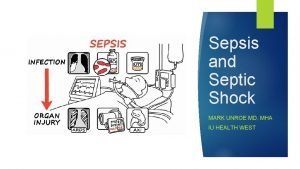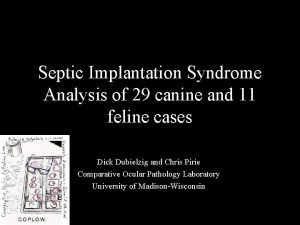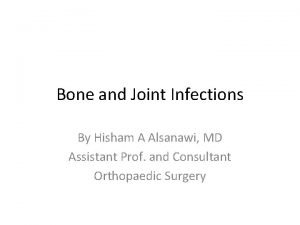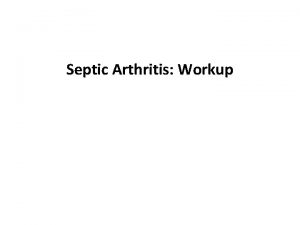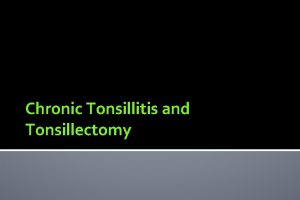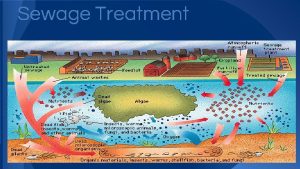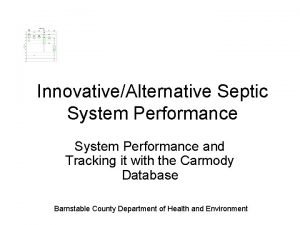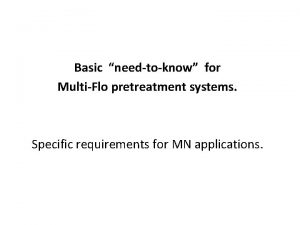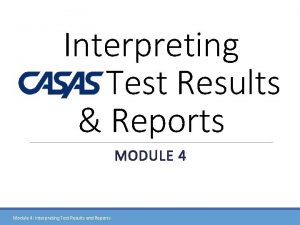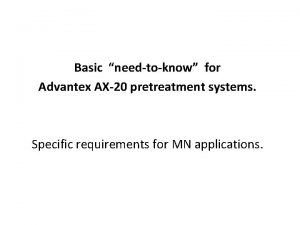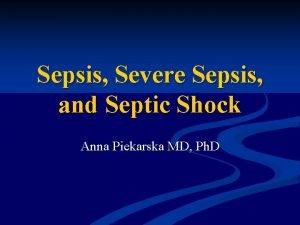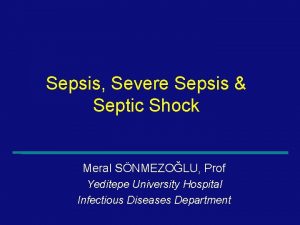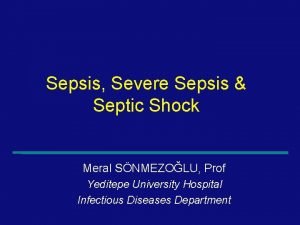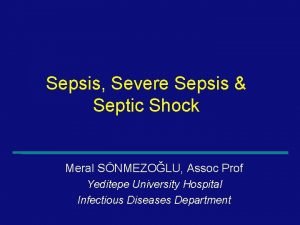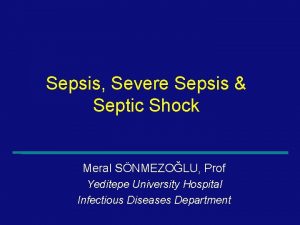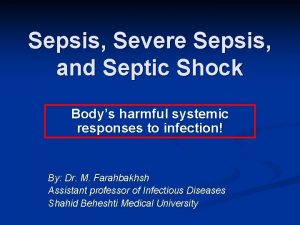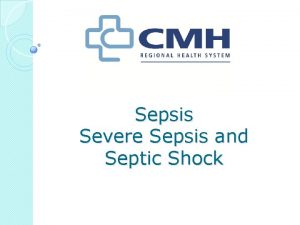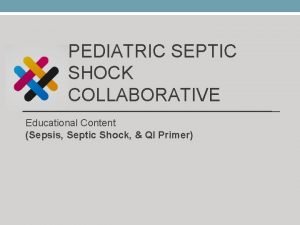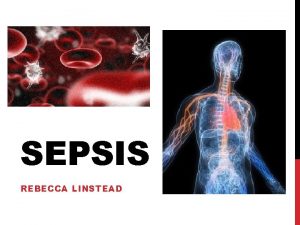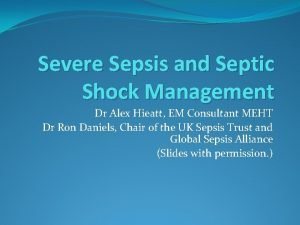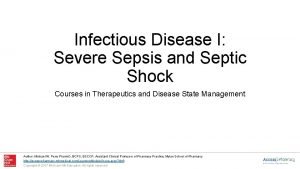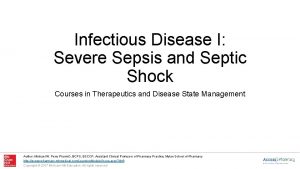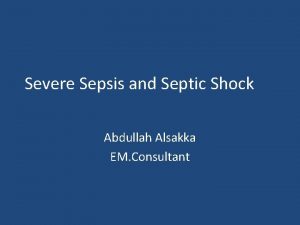Promoting Clear Identification of Sepsis Severe Sepsis Septic


















- Slides: 18

Promoting Clear Identification of Sepsis, Severe Sepsis & Septic Shock ICD-9 -CM Coordination and Maintenance Committee Meeting December 6 th, 2002 Howard Levy, MD, Ph. D, MMM 1

Overview • Differentiation between Septic Shock in relation to other conditions in current code, Sepsis, and Severe Sepsis • Disease Epidemiology, Incidence and Mortality • Inadequacy of Current Diagnostic Codes • Proposed Modifications and Clarification • Discussion 2

Sepsis: Defining a Disease Continuum Infection/ Trauma SIRS A clinical response arising from a nonspecific insult, including 2 of the following: • • Temperature 38 o. C or 36 o. C HR 90 beats/min Respirations 20/min WBC count 12, 000/mm 3 or 4, 000/mm 3 or >10% immature neutrophils Sepsis Severe Sepsis SIRS with a presumed or confirmed infectious process SIRS = Systemic Inflammatory Response Syndrome Adapted from: Bone RC, et al. Chest 1992; 101: 1644 Opal SM, et al. Crit Care Med 2000; 28: S 81 3

Sepsis: Defining a Disease Continuum Infection/ Trauma SIRS Sepsis Severe Sepsis with 1 sign of organ failure Cardiovascular (refractory hypotension) Renal Respiratory Hepatic Hematologic CNS Metabolic acidosis Shock Bone et al. Chest 1992; 101: 1644; Wheeler and Bernard. N Engl J Med 1999; 340: 207 4

Relationship Of Infection, SIRS, Sepsis Severe Sepsis and Septic Shock SEPSIS PANCREATITIS SEVERE SEPSIS INFECTION SEPTIC SHOCK SIRS BURNS TRAUMA OTHER 5 Bone et al. Chest 1992; 101: 1644

Mortality Increases in Septic Shock Patients Incidence Mortality Sepsis 400, 000 7 -17% Severe Sepsis 300, 000 Septic Approximately 200, 000 patients including 70, 000 Shock Medicare patients have septic shock annually Balk, R. A. Crit Care Clin 2000; 337: 52 20 -53% 53 -63% 6

Definitions & Current Convention • Sepsis (currently included in 038. x) Systemic inflammatory response to known or suspected infection • Severe Sepsis (995. 92 + 038. x) SIRS associated with organ dysfunction (failure), hypoperfusion, and perfusion abnormalities 7 Bone, R et al. Chest 1992; 101: 1644

Definitions Continued • Septic shock (currently included in 785. 59) A subset of severe sepsis, where patients experience combined decreased systemic vascular resistance and the presence of reduced myocardial performance 8 Bone, et al. CHEST , 1992; 101: 1644

Inadequacy of Existing Codes • Septic shock is bundled with non-related diagnoses for non-traumatic shock in 785. 59 including: —Extracardiac obstructive shock § § § Pericardial tamponade Constrictive pericarditis Pulmonary embolism —Oligemic shock § § Dehydration Hemorrhage Parrillo JE. Ann Intern Med 1990; 113: 227 9

Septic Shock is Unique within 785. 59 785. 5 Unspecified Shock 7% 10, 100 785. 59 Other Shock 62% 785. 59 Details Population Mortality Length Of Stay 45, 200 88, 600 785. 51 Cardiogenic Shock 31% Cost With infection * 70, 900 51% 17. 1 $30, 300 Without infection 17, 700 52% 8. 9 $17, 400 * Represents Septic Shock Patients ICD-9 -CM code 785. 5 X Population Septic Shock patients have a longer length of stay and a higher cost than other patients within 785. 59 10

Modification to Septic Shock Coding • Create unique code to identify septic shock 785. 52, septic shock • Use additional code (995. 92) to identify severe sepsis • Remove term “septic” from 785. 59, other shock without mention of trauma & 998. 0, postoperative shock • Add “excludes septic shock (785. 52)” from 998. 0, postoperative shock • Add notation to 995. 92 to code also “septic shock” (785. 52) 11

Modification to SIRS Codes • Sepsis should be indexed to 995. 91, as it is defined as SIRS due to infection without organ failure — Code also 038. x • 995. 92 should include link to the new Septic Shock code, as Septic Shock is a subset of Severe Sepsis — Modification will ensure adoption and proper use — Without these modifications, valuable data on mortality, morbidity, and utilization will be lost 12

Modification on SIRS Codes (Cont. ) • Include the following organ dysfunction examples under 995. 92 —Respiratory failure —Acute renal failure —Hepatic failure —Septic shock (518. 81) (584) (573. 9) (785. 52) • Delete heart failure under 995. 92, as this is related to Septic Shock (785. 52) 13

Conclusion • Septic shock has distinct characteristics that support the creation of a unique code (785. 52) • Septic shock should be linked to severe sepsis • Modification of current SIRS coding will better represent the clinical presentation of the sepsis syndrome — 995. 51, sepsis — Modification to “code also” list in 995. 92 14

15

Deficiencies of 1991 Consensus Conference • Limitations inherent in these definitions: —Incomplete agreement as to what defines “Systemic Response" § Inflammation only? —Organ/System failures not defined § Except hypotension (SBP <90 mm. Hg or >40 mm. Hg decline from baseline; need for vasopressor support) "Dear SIRS, I do not like you" Jean Louis Vincent 16

2001 Sepsis Definitions Conference • Current definitions will remain unchanged • However, will accept the uncertainty of definitions • SIRS expanded to signs and symptoms — Chills — Alteration in temperature — Tachypnea — Change in mental status — Tachycardia — Altered WBC, Bandemia — Thrombocytopenia — Decreased perfusion: mottling, poor capillary refill — Increased blood sugar — Petichiae/Purpura 17

2001 Sepsis Definitions Conference • PIRO staging system proposed —Predisposition: —Insult: —Response: —Organ Dysfunction: Genetics, Chronic illness Infection, Injury, Ischemia Physiologic, Mediators, Markers Outcome, Organ dysfunction To be published 2002 (Verbal communication Mitchell Levy, SCCM 2002) 18
 Quick sofa
Quick sofa Positive identification
Positive identification Rock solid precast
Rock solid precast Septic implantation syndrome
Septic implantation syndrome Haemophilus ducreyi culture media
Haemophilus ducreyi culture media Jea septic tank phase out
Jea septic tank phase out Septic arthritis antibiotics
Septic arthritis antibiotics Septic workup
Septic workup Septic squeeze test tonsillitis
Septic squeeze test tonsillitis Doc's septic tank cleaning
Doc's septic tank cleaning Septic arthritis complications
Septic arthritis complications Carmody septic
Carmody septic Septic tank contamination groundwater
Septic tank contamination groundwater Example of gram negative cocci
Example of gram negative cocci Multiflow septic system
Multiflow septic system Qqq10
Qqq10 Septic
Septic Advantex septic system reviews
Advantex septic system reviews Enthesitis
Enthesitis
